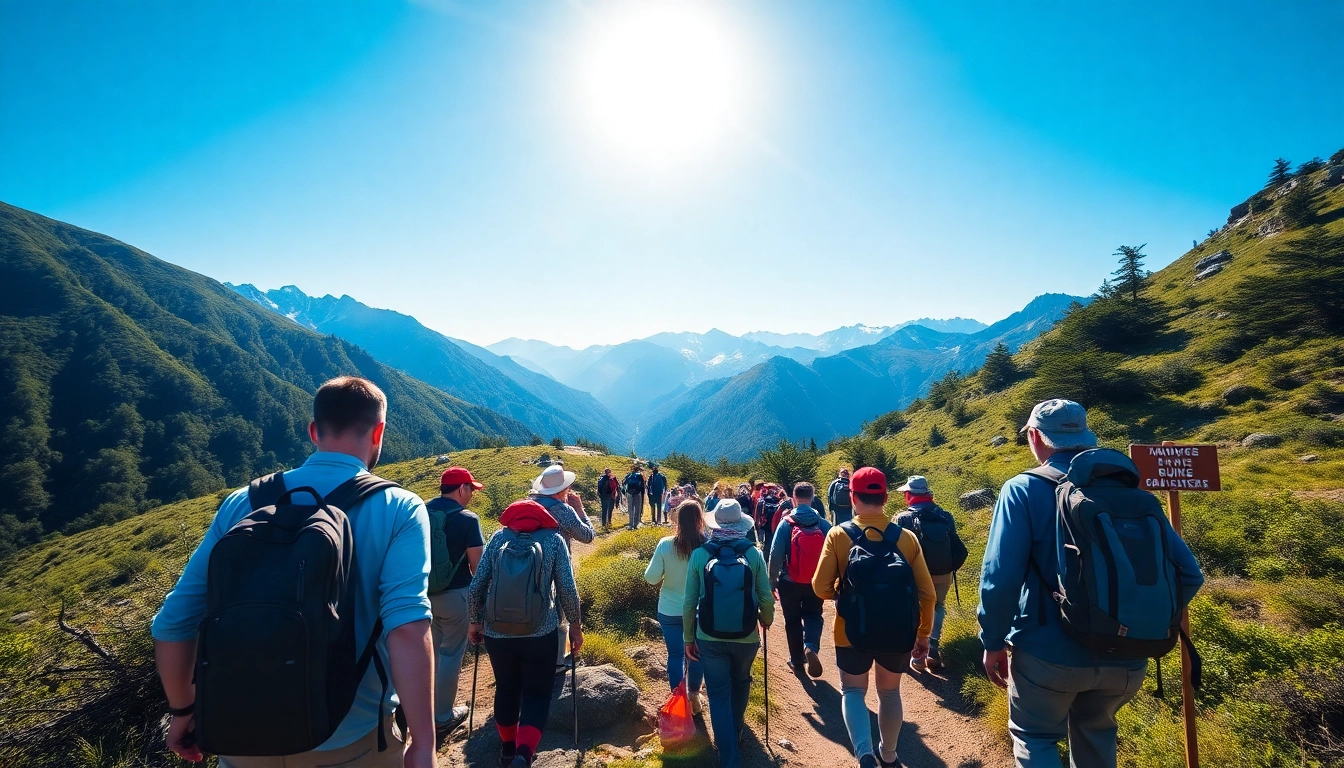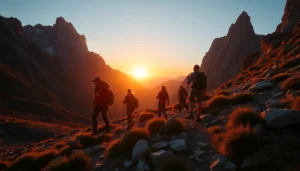Understanding the Guided Trek Experience
What defines a guided trek and its benefits
A guided trek is an organized journey on foot through natural landscapes, orchestrated and led by experienced guides who possess an in-depth knowledge of the terrain, local culture, flora, and fauna. This form of trekking is not merely about reaching a destination; it emphasizes exploration, safety, and education, offering participants a comprehensive experience that marries adventure with learning. Guided treks are often multi-day endeavors, allowing travelers to immerse themselves deeply into remote or culturally rich environments.
The benefits of engaging in a guided trek are manifold. Primarily, it ensures safety, especially in unfamiliar or challenging terrains, by leveraging the expertise of seasoned guides who navigate risks such as unpredictable weather, difficult paths, and wildlife encounters. It also enhances the overall experience through local insights, storytelling, and cultural interactions, transforming a physical activity into an enlightening journey. Additionally, guided treks streamline logistics—accommodations, permits, food, and transportation—allowing participants to focus solely on enjoyment and discovery. For those seeking an authentic connection with nature without the stress of planning, a guided trek in guided trek options in Lombok and Indonesia offers unparalleled convenience and adventure.
Key differences between hikes and treks
While the terms “hike” and “trek” are often used interchangeably, they denote distinct types of outdoor journeys, each with unique characteristics. Hiking typically refers to a leisurely walk on well-marked trails, often lasting a few hours, and is accessible to most fitness levels. It is associated with short, recreational excursions that emphasize scenic beauty and relaxed pace.
Trekking, on the other hand, involves longer, more strenuous journeys often over multiple days, traversing diverse terrains such as mountains, jungles, or deserts. Treks require a higher level of physical endurance, preparation, and often include camping or staying in remote lodges. The purpose of trekking is usually exploration and adventure in less accessible environments, making it more challenging yet profoundly rewarding.
Understanding this distinction is crucial when selecting your experience, as it influences the level of physical effort, logistical planning, and the kind of support you’ll need. For instance, a guided trek through the lush landscapes of Lombok’s mountains provides an immersive, multi-day challenge, whereas guided hiking might involve a manageable day trip to a scenic viewpoint.
Types of guided treks suitable for different travelers
Guided treks cater to a broad spectrum of travelers, from beginners to seasoned adventurers. Here are some common types:
- Introductory Treks: Designed for novices, these treks are shorter, less physically demanding, and often include beginner-friendly trails with guided explanations about local ecosystems and culture. Examples include short mountain walks or jungle excursions.
- Intermediate Treks: Suitable for travelers with some experience in outdoor activities, these may span multiple days and include more challenging terrain, such as steep ascents or river crossings.
- Advanced and Expert Treks: For seasoned trekkers, these treks involve high-altitude climbs, remote wilderness, or technical routes. They demand excellent fitness, proper equipment, and often, specialized guides.
- Cultural & Thematic Treks: Focused on exploring local cultures, archaeological sites, or specific wildlife habitats, these treks blend adventure with educational experiences.
Selecting the right type depends on your fitness level, experience, interests, and the kind of challenge you seek. For example, a guided trek in Lombok offers options ranging from gentle village walks to rugged mountain ascents, ensuring every traveler finds a suitable adventure.
Planning Your Perfect Guided Trek
Selecting the right guided trek based on skill level
The foundation of a memorable trekking experience lies in choosing a trek aligned with your physical abilities and prior experience. Beginners should look for guided treks that prioritize safety, manageable daily distances, and accessible routes. Experienced trekkers, on the other hand, may opt for more challenging terrains with varied elevation gains and technical elements.
To select an appropriate trek, assess factors such as total distance, maximum altitude, daily physical demands, and acclimatization needs. Photographs, detailed itineraries, and testimonials from past participants can provide insights into the trek’s difficulty. Reputable providers will offer pre-trek support, including training tips or acclimatization strategies, to ensure participants are prepared.
For example, if you’re considering a guided trek in Indonesia, look for modules that specify the trek’s difficulty level and the recommended fitness prerequisites. Many operators also offer training advice to help you optimize your readiness.
Top locations for guided treks in Lombok and Indonesia
Indonesia, with its diverse landscapes and rich biodiversity, offers some of the world’s most exciting guided trekking destinations. Lombok, in particular, stands out as an exceptional location, renowned for its majestic mountains, volcanic landscapes, and vibrant culture. Here are some top trekking regions in Lombok and Indonesia:
- Mount Rinjani: Indonesia’s second-highest volcano, Mount Rinjani, offers a challenging multi-day trek to its crater rim, with breathtaking views of lakes, hot springs, and surrounding islands. Guided treks here attract climbers of all levels, with options for overnight camping and cultural encounters with Sasak tribes.
- Segara Anak Lake: Nestled within Rinjani’s caldera, this volcanic crater lake is a highlight for those on guided treks seeking natural beauty and serenity.
- Serengeti-like Grasslands and Jungle Trails: Explore Lombok’s lush forests, waterfalls, and traditional villages, gaining insight into local cultures and flora.
- Komodo National Park: For wildlife enthusiasts, guided treks on Komodo Island involve spotting Komodo dragons, exploring pristine beaches, and snorkeling in vibrant coral reefs.
Each destination provides unique experiences tailored to different interests—whether rugged mountain climbing or cultural immersion—guaranteeing a memorable adventure.
Essential gear and preparation tips for a guided trek
Proper preparation is vital for a successful guided trek. Essential gear varies depending on the environment and trek difficulty but generally includes:
- Footwear: Durable, comfortable hiking boots with good ankle support for uneven terrain.
- Clothing: Layered moisture-wicking base layers, insulating mid-layers, waterproof jacket, and quick-dry pants.
- Backpack: A lightweight, ergonomic pack to carry essentials such as water, snacks, and extra clothing.
- Navigation and Safety Equipment: Maps, compass or GPS device, headlamp, and a personal first aid kit.
- Other essentials: Sunglasses, sunblock, insect repellent, trekking poles, and a camera or binoculars.
Prior to the trek, undertake conditioning exercises to improve endurance and strength, especially for high-altitude or multi-day treks. Hydration and nutrition planning, along with understanding weather conditions, can significantly influence your experience.
Also, discuss with your guide about local customs, environmental protocols, and emergency procedures. Because guided treks often include logistical arrangements (permits, accommodations), following pre-briefings ensures safety and enjoyment.
Choosing the Best Guided Trek Provider
Features of reputable trekking companies
Leading trekking providers prioritize safety, ecological sustainability, and cultural respect. Reputable companies typically have:
- Certified guides with extensive local knowledge and first aid certification.
- Clear, transparent itineraries with detailed descriptions of daily activities.
- Strong safety protocols, including risk assessments and emergency response plans.
- Environmental responsibility initiatives, such as waste management and conservation efforts.
- Positive customer reviews and industry affiliations or certifications.
When selecting a provider, verify their credentials, safety records, and commitments to responsible tourism. This ensures your adventure aligns with best practices and supports local communities.
How to evaluate guides’ expertise and safety standards
Guides are the cornerstone of a successful guided trek. Assess their expertise by examining their qualifications, experience, language skills, and familiarity with the terrain. A skilled guide should demonstrate:
- Certifications from recognized outdoor or mountaineering authorities.
- Extensive local knowledge and cultural insights.
- Proven safety track record and familiarity with emergency procedures.
- Ability to communicate clearly and motivate participants.
Safety standards are equally critical. Reputable companies adopt protocols such as regular equipment checks, contingency plans, and thorough pre-trek briefings. Asking questions about their experience with crisis management can provide confidence in their professionalism.
Customer reviews and testimonials: what to prioritize
Reading customer testimonials offers real-world insights into the quality and reliability of a guided trek provider. Prioritize reviews that comment on guide professionalism, logistical organization, safety measures, and overall experience. Consistent mention of personalized attention, punctuality, and environmental consciousness reflects well on the company.
Platforms like TripAdvisor or specialized adventure travel forums can be valuable resources. Remember, a few negative reviews are inevitable, but widespread positive feedback indicates trustworthiness and high standards.
Enhancing Your Trekking Adventure
Incorporating local culture and scenery into your trek
One of the most enriching aspects of guided treks is the opportunity to explore local cultures, traditions, and environments intimately. Engage with local communities respectfully—participate in cultural rituals, sample traditional foods, and learn about their history from your guide. Incorporating visits to villages or local markets can deepen your understanding and appreciation of the region.
In Lombok, for example, guided treks often include interactions with Sasak tribes, visiting traditional weaving workshops, and witnessing ancient temples nestled within stunning landscapes. Such experiences make your trek more meaningful and memorable.
Making the most of guided knowledge and storytelling
Guided treks excel in providing educational value through storytelling, detailed explanations, and cultural anecdotes. Be proactive in asking questions about the flora, fauna, geology, and history of the area. Guides often share legends, ecological facts, and personal experiences that transform the journey from physical exertion into an engaging story.
Taking notes or recording stories can help retain information and share your experiences later. The personal touch of a knowledgeable guide enhances the overall value and enjoyment of your trek.
Post-trek tips for maintaining adventure momentum
After completing your guided trek, keep the spirit of adventure alive by staying physically active, exploring new outdoor activities, or planning your next journey. Reflect on the lessons learned, and consider sharing your experience through reviews or social media to inspire others.
Maintaining good health, hydration, and environmental responsibility ensures you’re ready for future adventures. Remember, every trek is a stepping stone to greater exploration and personal growth.
Measuring Success and Safety in Guided Treks
Key performance indicators for a successful trek
Evaluating the success of a guided trek involves several metrics:
- Participant Satisfaction: Positive feedback on guides, itinerary, and overall experience.
- Safety Record: Minimal incidents, adherence to safety protocols, and efficient emergency response.
- Environmental Impact: Responsible waste management and conservation practices.
- Cultural Respect: Engagement with local communities with sensitivity and mutual benefit.
- Achievement of Objectives: Participants successfully completing the trek and gaining knowledge or skills.
Regular monitoring of these indicators helps ensure continual improvement and quality assurance.
Safety protocols and risk management
Safety is paramount in any guided trek. Companies implement comprehensive risk management plans, including detailed pre-trek briefings, weather assessments, and emergency evacuation procedures. Guides are trained to handle common hazards such as altitude sickness, injuries, or sudden weather changes.
Participants should be encouraged to disclose health issues beforehand, carry prescribed medications, and adhere to guide instructions strictly. Ensuring proper equipment, maintaining communication channels, and conducting regular safety drills further mitigate risks.
Building confidence for future independent adventures
Completing a guided trek significantly boosts your confidence in outdoor skills, navigation, and resilience. Use this experience as a foundation to venture on independent trips, gradually increasing difficulty and complexity. Learning about navigation, first aid, and environmental stewardship during guided treks prepares you for autonomous exploration.
Additionally, cultivating a respectful attitude towards nature and local cultures ensures sustainable and fulfilling adventures in the future.




